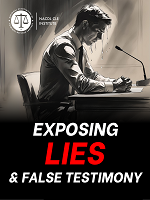Ava DuVernay’s recent Netflix series When They See Us chronicles the heartbreaking story of the Central Park Five (now more appropriately known as “the Exonerated Five”) — Yusef Salaam, Kevin Richardson, Antron McCray, Raymond Santana, and Korey Wise — who were wrongfully convicted of a notorious 1989 assault and rape in New York City.{1} 1 Jim Dwyer, The True Story of How a City in Fear Brutalized the Central Park Five, N.Y. Times, May 30, 2019, https://www.nytimes.com/2019/05/30/arts/television/when-they-see-us-real-story.html. The series lays bare that the fate of five people was decided in an environment — plagued by racial hysteria — that presumed their guilt from the very beginning. Indeed, the false confessions that were extracted from some of the five teenagers were a product of coercive, guilt-presumptive, interrogation techniques. The series provides a stark reminder of the importance of reshaping police practice in the interrogation room through both the recording of interrogations and the use of modern, non-deceptive interrogation methods. It also cautions us about the lingering need to shift how American judges assess the confession evidence that comes before them.
The decades since the Exonerated Five case have seen a flow of exonerations across the nation that continue to illustrate how and why people falsely confess, and a growing demand for oversight in the interrogation room and protections designed to reduce the risk of false and/or coerced confessions. Currently, 28 percent of the nation’s 367 wrongful convictions overturned with DNA evidence involved a false confession or admission. By 2020, policy reform efforts have led to 27 states and the District of Columbia requiring electronic recording of certain interrogations in their entirety. While these numbers represent significant national progress, they are also a reminder of how much work is left to be done in the interrogation room.
This article explores the underlying causes of false confessions and the importance of state-level reform in protecting against wrongful convictions by mandating the recording of interrogations and addressing some of the tactics and methods employed by law enforcement. It also discusses how the shared responsibility in addressing the false confession phenomenon must extend beyond the police station; courts must also act to transform how they assess confession evidence before it can be considered by fact-finders. The article provides an overview of the more recent progress in reforming policy and practice related to interrogations, how the national landscape has shifted over time, and what lies ahead.
Why Do Innocent People Falsely Confess?
The false confession is a counterintuitive phenomenon. For many it can be difficult to understand why people would confess to a crime they did not commit. Researchers who study this phenomenon have determined that both dispositional and situational factors contribute to people confessing to crimes they did not commit.
Dispositional Factors
Dispositional factors refer to pre-existing elements such as a person’s age, personality traits, and mental limitations, which can affect how vulnerable they will be to suggestion and coercive interrogation techniques. People with mental limitations are particularly vulnerable to interrogative pressure and are disproportionately represented in the numbers of actual false confessions that have been documented.{2} 2 S.M. Kassin & G.H. Gudjonsson, The Psychology of Confessions: A Review of the Literature and Issues, 5(2) Psychol. Sci. Pub. Interest 33-67 (2004). This group of people is often more vulnerable to falsely confessing due to documented factors such as lower than average comprehension of their Miranda rights and ability to invoke them; limitations in cognitive and linguistic abilities; a greater tendency toward social compliance; and a higher likelihood of internalizing false information that is repeatedly fed to a suspect in an interrogation context.{3} 3 Ibid. Some people are more vulnerable than others to be compliant or suggestible in an interrogation setting, including youth who are taught to be compliant with adults and authority figures alike.{4} 4 Ibid.
Youth itself has been well-documented as a “substantial risk factor for false confessions.”{5} 5 Ibid. Research shows that child witnesses are more compliant and more suggestible than adult witnesses, and are more likely to internalize and “subscribe to memories of fictitious events when exposed to repetition, leading questions, peer pressure, and other social influences tactics.”{6} 6 M. Bruck & S.J. Ceci, The Suggestibility of Children’s Memory, 50 Annual Rev. Psychol. 419 (1999); S.J. Ceci & M. Bruck (1995) (cited in Kassin & Gudjonsson, 2004, at 52). Youth are also particularly susceptible to pressure and negative feedback in an interrogation context, and generally have been shown to have a significantly poorer comprehension of their Miranda rights than adults do.{7} 7 S.M. Kassin, S.A. Drizin, T. Grisso, G.H. Gudjonsson, R.A. Leo, & A.D. Redlich, Police-Induced Confessions: Risk Factors and Recommendations, 34 Law & Hum. Behav. 3–38 (2010). Additionally, young people are generally primarily concerned with their immediate predicament and tend to think less of longer term consequences than adults do, which can result in young people more easily caving to interrogative pressure in order to simply get out of the interrogation.{8} 8 Ibid. That said, it is important to remember that mentally capable adults are not immune to the false confession.
Situational Factors
Situational factors refer to elements of a person’s immediate situation that can increase the likelihood of a false confession.{9} 9 S.M. Kassin, False Confessions: Causes, Consequences, and Implications for Reform, 17(4) Current Directions in Psychol. Sci. 249-253 (2008). Suspects who feel intimidated or physically threatened by law enforcement are susceptible, as are those who fear harsher legal consequences if they do not confess.{10} 10 B.L. Garrett, The Substance of False Confessions, 62(4) Stan. L. Rev. 1051-1119 (2010). Situational factors that have been shown to lead to false confessions also include compromised reasoning abilities due to exhaustion, stress, hunger, substance use, and, in some cases, mental limitations or limited education.{11} 11 S.M. Kassin, The Psychology of Confessions, 4 Annual Rev. Law Soc. Sci. 193–217 (2008); B.L. Garrett, The Substance of False Confessions, 62(4) Stan. L. Rev. 1051-1119 (2010). Additionally, the physical setting of an interrogation can make people more vulnerable to coercion, particularly the use of isolation and confinement to an unfamiliar setting in which they have no control.{12} 12 S.M. Kassin & G.H. Gudjonsson, The Psychology of Confessions: A Review of the Literature and Issues, 5(2) Psychol. Sci. Pub. Interest 33-67 (2004); B.L. Garrett, The Substance of False Confessions, 62(4) Stan. L. Rev. 1051-1119 (2010).
Significantly, utilization of many of the above situational factors has historically been the basis of popular interrogation techniques.{13} 13 S.M. Kassin & G.H. Gudjonsson, The Psychology of Confessions: A Review of the Literature and Issues, 5(2) Psychol. Sci. Pub. Interest 33-67 (2004). The use of intimidation and the deprivation of a suspect’s basic needs in today’s interrogation room can be traced back to earlier eras of police interrogation. Interrogation methods employed through the 19th to early 20th centuries in the United States explicitly permitted the physical torture of suspects, i.e., the so-called “third degree.”{14} 14 S.A. Drizin & R.A. Leo, The Problem of False Confessions in the Post-DNA World, 82 N.C. L. Rev. 891–1007 (2004). While more states are taking action to put safeguards in place to deter coercion in the interrogation room, law enforcement’s use of intimidation, deprivation, prolonged interrogations and, in some instances, physical abuse, still remain significant factors that lead innocent people to falsely confess.{15} 15 B.L. Garrett, supra note 10.
Coercive Interrogation Techniques Lead to False Confessions
Since physical abuse is no longer legally permissible, psychological techniques have replaced traditionally physically coercive ones. Many commonly-employed interrogation techniques involve coercive tactics that leverage both dispositional and situational factors.{16} 16 Ibid. Common coercive interrogation techniques include law enforcement misleading suspects about the presence of incriminating evidence, and minimizing the suspect’s alleged involvement in the crime by suggesting to suspects that “their actions were spontaneous, accidental, provoked, peer pressured, drug induced, or otherwise justifiable by external factors.”{17} 17 S.M. Kassin & G.H. Gudjonsson, supra note 2. While law enforcement’s use of deceptive statements about the presence of incriminating evidence can compel even a mentally capable person into falsely confessing, research also shows that people with mental limitations are particularly influenced by questions containing misleading information.{18} 18 N.B. Perlman, K.I. Ericson, V.M. Esses & B.J. Isaacs, The Developmentally Handicapped Witness: Competency as a Function of Question Format, 18(2) Law & Hum. Behav. 171–187 (1994) (cited in Kassin & Gudjonsson, 2004, at 53). Additionally, a suspect’s fear that failure to confess will yield a harsher punishment is often motivation for giving a false confession to obtain a seemingly better legal outcome.{19} 19 S.A. Drizin & M.J. Reich, Heeding the Lessons of History: The Need for Mandatory Recording of Police Interrogations to Accurately Assess the Reliability and Voluntariness of Confessions, 52 Drake L. Rev. 619–46 (2004).
The case of the Exonerated Five provides a good illustration of how easily a combination of coercive interrogation techniques and situational and dispositional factors can lead to wrongful convictions. Teenagers when they were brought in for questioning about the 1989 rape and assault of a jogger in Central Park,{20} 20 Jim Dwyer, supra note 1. they were subjected to highly coercive and deceptive police interrogations. Detectives interrogated the sleep-deprived boys for hours on end, implied they could go home if they just confessed, utilized overly accusatory and threatening interrogation techniques, employed physical violence, and lied about the presence of incriminating evidence.{21} 21 R.A. Leo et al., Bringing Reliability Back In: False Confessions and Legal Safeguards in the Twenty-First Century, 479 Wis. L. Rev. 479–539 (2006).
After enduring the interrogations, sleep-deprived Richardson, McCray, Santana, and Wise all gave confessions that were captured on videotape. However, only their admissions of guilt were recorded and isolated from the hours of an unrecorded abusive interrogation that preceded the confessions. The teenagers all recanted their confessions upon being officially arrested, but the videotaped confessions were compelling evidence that ultimately led to their convictions.{22} 22 Id. Had the juries that convicted the boys witnessed their interrogations in full, they would have seen the coercive methods inflicted upon the teenagers as well as the inconsistencies in the statements they provided about the crime. Unfortunately, though, no true record was ever made.
Protecting Against False Confessions by Recording Interrogations
Recording interrogations in their entirety, beginning when a person reasonably believes himself or herself to be in custody, can help prevent false confessions from leading to wrongful convictions.{23} 23 S.A. Drizin & M.J. Reich, Heeding the Lessons of History: The Need for Mandatory Recording of Police Interrogations to Accurately Assess the Reliability and Voluntariness of Confessions, 52 Drake L. Rev. 619–46 (2004). First, a record is created of the entire interrogation, including the interaction leading up to the confession, which can reveal whether a suspect was read his or her rights and how well the suspect may have comprehended them. Recording also creates a deterrent against improper or coercive techniques that might be employed absent the presence of a recording device.{24} 24 S.M. Kassin, S.A. Drizin, T. Grisso, G.H. Gudjonsson, R.A. Leo, & A.D. Redlich, Police-Induced Confessions: Risk Factors and Recommendations, 34 Law & Hum. Behav. 3–38 (2010). In cases in which an officer would otherwise make a written account of the interrogation and/or confession obtained from it, a recording can prevent important statements or context from being omitted from the official record either intentionally or unintentionally.{25} 25 Ibid. Lastly, through the recording of investigators, prosecutors, judges and juries are more likely to be attuned to whether the suspect appeared to have any mental limitations or other evident vulnerabilities that might make him more susceptible to a false confession.{26} 26 Samson J. Schatz, Interrogated with Intellectual Disabilities: The Risks of False Confession, 70 Stan. L. Rev. 643 (2018).
Law enforcement also benefits from recording interrogations. Recording interrogations creates a more accurate and objective record of what transpired during an interrogation, and can therefore be a valuable tool for contesting untrue allegations of coercion or other misconduct.{27} 27 S.M. Kassin et al., supra note 24. By creating a record of statements directly made by the suspect, recording interrogations makes it difficult for a defendant to change an account of events originally provided to law enforcement. Additionally, officers are able to concentrate on the interview itself rather than being distracted by excessive note-taking during the course of the interrogation.{28} 28 Ibid. Recording may also capture subtle details that may be lost if unrecorded, which helps law enforcement better investigate the crime.{29} 29 Ibid. Finally, the practice of recording interrogations helps enhance public confidence in the criminal justice system because it provides greater transparency in one of the system’s most consequential processes.
National Movement to Require Recorded Custodial Interrogations
In its efforts to combat and prevent false confessions, the Innocence Project and its domestic partners in the Innocence Network, an affiliation of 55 U.S.-based organizations dedicated to providing pro bono legal and investigative services to individuals seeking to prove innocence of crimes for which they have been convicted, began its advocacy by pushing for statewide mandates — in the state houses and the state courts — requiring law enforcement to electronically record custodial interrogations. Today, 27 states and the District of Columbia have passed laws or taken court action (through case law or court rule) requiring statewide mandatory recording of certain interrogations in their entirety. Additionally, the U.S. Department of Justice issued a policy in 2014 for federal law enforcement agencies, including the FBI, DEA and ATF, to record interrogations of individuals suspected of any federal crime.
In recent years there has been a significant shift in the national landscape on recording interrogations. A decade ago, only 14 states required the recording of interrogations. {30} 30 Alaska, Ill., Ind., Mass., Me., Md., Minn., Mo., Mont., Neb., N.J., N.M., N.C., and Wis. In the past five years alone, seven additional states have mandated the practice. When the DOJ issued its policy in 2014, it reversed a 100-year-old ban on federal law enforcement agencies recording interrogations.{31} 31 https://web.williams.edu/Psychology/Faculty/Kassin/files/DOJ%202014%20-%20Policy%20Pro%20Recording.pdf. This foundational reform provides fact-finders with a more accurate and intimate look inside of the interrogation room than ever before. Capturing interrogations on video has further exposed the prevalence of certain risk factors that lead to wrongful convictions, such as inconsistencies between what a suspect says and the known facts about a crime, the effect of interrogative techniques on people with mental limitations and other vulnerabilities, the deleterious effect of a protracted interrogation, and commonly-employed coercive interrogation methods, including the use of deception.
The Value of a Mandate
Without a statewide mandate for recording interrogations, there is a lack of uniformity in practice across law enforcement agencies. Individual agency policies often vary, which leaves significant gaps in protection for suspects and allows for different standards of interrogation evidence-gathering across a single state. Without a mandate there is no enforcement mechanism to ensure that law enforcement agencies are recording interrogations as their individual policies may provide for, and there is certainly no enforcement for agencies lacking their own policies. An officer could choose to start and stop recording whenever he or she wants, or choose to not record at all without any legal consequences. While a defense attorney could cross-examine the officer about why she did not record the interrogation, this likely would have little effect on jurors because the officer could simply explain that the law was not violated.{32} 32 S.A. Drizin & M.J. Reich, supra note 23.
Nationally, mandatory recording of interrogations statutes and court rulings vary in scope and substance. However, there are some commonalities in every law and court ruling. For instance, all requirements apply only to “custodial” interrogations, typically defined as an interrogation during which a reasonable person would consider himself or herself to be in custody and law enforcement officers conduct questioning that is likely to elicit an incriminating response.{33} 33 Alaska, Cal., Colo., Conn., D.C., Ill., Ind., Kan., Mass., Me., Md., Mich., Minn., Mo., Mont., Neb., N.J., N.M., N.C., Nev., N.Y., Okla., Or., Utah, Tex., Vt., and Wis. In addition, all mandates specify that recording is only required in a “place of detention,” which is typically defined as a fixed location that is owned or operated by a law enforcement agency where individuals may be held in detention in connection with criminal charges.{34} 34 Alaska, Cal., Colo., Conn., D.C., Ill., Ind., Kan., Mass., Me., Md., Mich., Minn., Mo., Mont., Neb., N.J., N.M., N.C., Nev., N.Y., Okla., Or., Utah, Tex., Vt., and Wis. In other words, the recording requirement would not apply to interviews conducted at a crime scene, patrol car, or other locations. Notable variances among state mandates include the following: the crime categories for which interrogations must be recorded, allowable exceptions to the requirement to record, consequences for noncompliance, and circumstances that warrant exemption.
Coverage of Crime Categories
The majority of states require recording of interrogations for individuals suspected of specified violent crimes, particularly homicide and sexual assault. These states include California, Colorado, Connecticut, Illinois, Kansas, Maine, Maryland, Michigan, Missouri, Nebraska, Nevada, New York, North Carolina, Oklahoma, Oregon, Texas, Vermont, and the District of Columbia. Four states require recording interrogations for individuals suspected of all felony crimes: Indiana, New Mexico, Utah, and Wisconsin. Additionally, four states require the practice for interrogations related to all crimes: Alaska, Minnesota, Montana, New Jersey, and Virginia.
Medium Used to Record Interrogations
Another variance between state mandates is the medium used to record interrogations. While video can capture actions, facial expressions, physical demonstrations and many other important variables, to address cost concerns the majority of states allow for audio-only recording. Four states — Maryland, North Carolina, Vermont, and Virginia — permit the use of audio devices while expressing a preference for video recording. Five states — California, Colorado, Connecticut, Indiana, and Michigan — require both video and audio recording, while three states — Maryland, North Carolina, and Vermont — do not specify which medium must be used. Additionally, seven states specifically require the retention of electronic recordings until final appeals and post-conviction procedures are exhausted.{35} 35 States with retention requirements: Cal., Conn., Ill., Me., Mont., N.C., and Or.
Remedies for Noncompliance
To ensure compliance, most states offer a remedy if law enforcement does not follow recording requirements, with the exception of Maine, Maryland, New Mexico, and Virginia. Eighteen states and the District of Columbia provide consequences for noncompliance that also vary but fall into a few distinct categories. Four states — Alaska, Indiana, Minnesota, and Utah — provide for automatic inadmissibility of unrecorded statements. Three states — Arkansas, Connecticut, and Illinois — and the District of Columbia provide for presumed or possible inadmissibility of unrecorded statements. Seven states — Colorado, Michigan, Montana, Nebraska, Oregon, Vermont, and Wisconsin — require juries to receive a cautionary instruction if there is an unexcused failure to record. Missouri is the only state with a statute that allows the governor to withhold state funds from a law enforcement agency if the agency is found to have not acted in good faith in attempting to comply with the law.{36} 36 V.A.M.S. § 590.700.
The majority of states provide the following exceptions to recording requirements: the suspect will only cooperate if he or she is not recorded,{37} 37 Alaska, Cal., Colo., Conn., D.C., Ill., Mich., Mo., Mont., Neb., N.M., N.J., N.C., Or., Utah, and Vt. the interrogation is conducted out-of-state,{38} 38 Ark., Cal., Conn., Ill., Ind., Mo., Mont., Neb., N.M., N.J., N.C., Or., Utah, and Vt. the recording equipment failed,{39} 39 Alaska, Cal., Colo., Ind., Mo., Mont., Neb., N.M., N.C., Or., Utah, Vt., and Wis. the investigator was unaware that the suspect was involved in an offense requiring an interrogation to be recorded,{40} 40 Cal., Conn., Ill., Ind., Neb., N.M., N.J., N.C., Or., Utah, Vt., and Wis. and the unrecorded statements were made during routine processing or booking.{41} 41 Ark., Cal., Conn., Ill., Ind., Mo., Mont., N.J., N.C., Or., Utah, and Wis. Several state mandates include exemptions for spontaneous statements made by the suspect,{42} 42 Ark., Conn., Ill., Mo., Mont., Neb., N.J., N.C., Or., Utah, and Wis. statements made before the grand jury or in open court,{43} 43 Ark., Conn., Ill., N.M., N.C., and Or. individual or public safety concerns,{44} 44 Cal., Colo., Or., Vt., and Wis. and other exigent circumstances.{45} 45 Ind., Mo., Mont., Or., Utah, and Vt.
Growing Support for Recording Interrogations
In the past couple of decades, support for the practice of recording custodial interrogations has steadily grown across a broad range of organizations representing criminal justice professionals, experts, and social justice interests. The National Association of Criminal Defense Lawyers (“NACDL”) adopted a resolution in 2002 supporting “the videotaping of law enforcement interrogations from beginning to end,” and called upon “Congress and state legislatures to pass legislation mandating this practice.”{46} 46 National Organizations on Recording Custodial Interrogations, National Association of Criminal Defense Lawyers, https://www.nacdl.org/Content/NationalOrgsonRecordingCustodialInterrogations.
The International Association of Chiefs of Police (“IACP”), the largest nonprofit membership organization of police executives, has long supported the practice of recording custodial interrogations. Starting in 2006, the IACP issued its model policy on the electronic recording of custodial interrogations, which directs law enforcement agencies to electronically record custodial interrogations in order to protect suspects against police coercion and interviewing officers against false accusations of misconduct.{47} 47 Id. In 2012, the IACP also adopted a model policy for interrogating juveniles, which recommends electronically recording the procedure.{48} 48 Id. In 2013, the IACP and U.S. Department of Justice’s Office of Justice Programs (“OJP”) hosted a national policy summit to create a comprehensive strategy to reduce wrongful convictions. The summit gathered professionals and experts from all corners of the criminal justice community, as well as experts in disciplines related to wrongful convictions, and ultimately issued a report containing recommendations to improve criminal justice policy and practice. In their recommendations, summit participants highlighted the importance of law enforcement leaders in identifying statewide protocols for recording suspect interviews.{49} 49 National Summit on Wrongful Convictions: Building a Systemic Approach to Prevent Wrongful Convictions, International Association of Chiefs of Police and U.S. Department of Justice, Office of Justice Programs Wrongful Convictions Summit (Aug. 2013).
More recently, the NAACP resolved in 2014 that its organization “advocate for states to electronically record all interrogations in felony cases in their entirety.”{50} 50 NAACP Resolution 2014: Preventing Wrongful Convictions by Improving Accuracy in Eyewitness Interrogation Techniques and Access to DNA Testing, NAACP (2014).
Limitations of Recording of Interrogations Laws
While more than half the country has implemented the electronic recordation of custodial interrogations through court action, legislation or voluntary policies, many of these mandates or policies contain major limitations. For instance, all statutes contain allowable exceptions to recordation, and in some instances it can be argued that the exceptions swallow the rule. In other instances, there are limited crime categories that are covered by the policy. Some laws are silent as to the remedy for a failure to record the interrogation. Two examples of limitations of existing laws in New York and Ohio are described below.
Implementation of New York’s Law
New York enacted a law mandating the recording of custodial interrogations in 2017. While otherwise robust, the law contains 10 allowable exceptions for failure to record an interrogation, including some that many would agree are overly broad, e.g., a statement not being recorded “as a result of an inadvertent error or oversight, not the result of any intentional conduct by law enforcement personnel,” or “if electronic recording equipment is not available because it was otherwise being used.”{51} 51 NY Crim. Pro. § 60.45. Some continue to argue that one could “drive a truck” through the allowable exceptions to recording. Three years after the passage of New York’s law, it is difficult to ascertain how often the exceptions are being applied and whether there has been compliance with the law. A bill was recently introduced in the New York Legislature that would require the degree of compliance with the law, including how often the various exceptions to recording are invoked by law enforcement.
Ohio: Authorized vs. Mandated Recording of Interrogations
Ohio enacted a law in 2010 that authorized, but did not require, the recording of custodial interrogations for people suspected of homicide and sexual assault.{52} 52 Ohio Rev. Code Ann. § 2933.81(A)(3), (B). The statute offered a “carrot” rather than a “stick” to encourage compliance by creating the presumption of voluntariness for all electronically recorded interrogations, and explicitly stated that failure to record an interrogation would not result in a penalty for law enforcement.
To measure compliance with the law, innocence organizations in Ohio surveyed Ohio police agencies about their obstacles to compliance with the requirements of the law. The results of the survey revealed that only 52 percent of the 253 agencies surveyed throughout the state had a recording policy, only 25 agencies required recording, and there were significant policy differences between the agencies that did report recording interrogations when it came to their use of audio and/or video recording and recording the entirety of the interrogation.{53} 53 Mark Godsey et al., Ohio Innocence Project — SB 77 Compliance Research Project, University of Cincinnati College of Law and School of Criminal Justice. Additionally, there was reported variation in the proportion of interrogations that agencies videotaped, and when it came to training, 70 percent of agencies reported that their employees were given interrogation training, but 21 percent of the agencies - primarily smaller municipal agencies - reported that their officers did not receive any training on interrogations.{54} 54 Id. Most agencies cited resource issues, such as the cost of equipment and lack of officer availability, as obstacles to implementing the 2010 law.{55} 55 Id.
In April 2016, the Ohio Supreme Court found the recording of interrogations law to be unconstitutional in the case of State v. Barker. In a 5-2 decision, the court ruled that the law violated the due process rights of juveniles because juveniles’ assertion that they understand their rights cannot be considered a “statement” presumed to be voluntary simply because it is electronically recorded.{56} 56 Dan Trevas, Law Presuming Juvenile’s Statement in Police Custody Was Voluntary Ruled Unconstitutional, Court News Ohio, Apr. 28, 2016, www.courtnewsohio.gov/cases/2016/SCO/0428/141560.asp#.XLntUDC6OUk. While the court specifically ruled on the law as it pertains to juveniles, its rationale in declaring the law unconstitutional extends to adults as well.
In 2020, the Innocence Project, in collaboration with Ohio-based innocence organizations, is advocating for new legislation to mandate the recording of custodial interrogations in Ohio. House Bill 277 was introduced in June 2019 and seeks to create a statewide requirement that law enforcement agencies electronically record custodial interrogations for homicide and sexual assault cases. The bill makes a couple of important clarifications in light of the 2010 law’s shortcomings. Rather than merely authorizing the electronic recording of interrogations, the bill requires law enforcement agencies to electronically record all statements made by a person suspected of a qualifying crime. The bill provides that failure to record an interrogation would result in a cautionary jury instruction and may be considered when a judge is ruling on a motion to suppress statements made during an interrogation.{57} 57 House Bill No. 277. General Assembly of the State of Ohio, 133rd General Assembly (2019-2020). Finally, the bill removes the language that electronically recorded statements “are presumed to be voluntary.”{58} 58 Id. The removal of this language will not only ensure that the waiver of one’s rights is not presumed to be voluntary, but that the voluntariness of any statements made in a recorded interrogation can still be probed contextually.
New Advocacy Efforts: What Comes Next in Preventing False Confessions
The national landscape for recording interrogations provides a snapshot of just how far advocacy and research around false confessions have come. It was not too long ago that false confessions were viewed as rare and isolated occurrences, as were wrongful convictions more generally. The increasing prevalence of proven wrongful convictions stemming from false confessions and a growing field of false confession research have paved the way for greater public understanding of factors that lead to false confessions, and have made possible much of the advocacy that resulted in over half of the states now requiring certain interrogations to be recorded.
Addressing the False Confession: Advocacy 2.0
While mandatory recording of interrogations was, and continues to be, a critical foundational reform to address false confessions by providing a record of what transpires in the interrogation room and serving as a deterrent to abuse and misconduct in the interrogation room, the next terrain of false confession reform work seeks to both address legally permissible but extremely problematic interrogation methods and the standards used by American courts in assessing the admissibility of confession evidence. The Innocence Project is embarking on a new initiative to build on the efforts to record interrogations in two major areas: barring the use of deception in the interrogation room and advancing a reliability assessment in courtrooms throughout the country.
Psychologically Coercive Methods in the Interrogation Room
Most police agencies in the United States use guilt-presumptive, confrontational interrogation methods as opposed to their European counterparts who use information-gathering techniques. Most concerning, perhaps, is the legally permissible and psychologically coercive technique of employing deception during an interrogation. These lies can range from false promises of leniency to outright deception about the presence of evidence that does not actually exist, e.g., telling a suspect her bloody palmprint was found at the crime scene or informing a suspect that he has failed a polygraph test. Factually innocent people from the Englewood 4 in Chicago to the Exonerated 5 in New York broke down and confessed to law police after law enforcement misrepresented that their friends or associates had implicated them. These forms of deception can induce innocent people to experience feelings of hopelessness and inevitability, sometimes even causing them to come to believe they committed the crime despite having no memory of having done so. For the first time, the Innocence Project has worked with lawmakers to introduce legislation that would ban the use of false facts during the course of interrogations in New York State.
Another feature of the American interrogation is the protracted interview of the suspect. Psychological research demonstrates that prolonged interrogations reduce the reliability of the confessions they enable and incentivize the innocent to confess. Psychological research also suggests that interrogations should last no longer than four hours (two hours for juveniles) and that any interrogation that exceeds six hours should be regarded as “legally coercive.” Indeed, 73 percent of 125 proven false confessions took place following interrogations that exceeded six hours. The Innocence Project has begun to explore several legislative fixes to this issue, ranging from the collection of data about the lengths of interrogations in states that record them to a mandate that outright limits the length of an interrogation.
Indeed, several additional aspects of the commonplace American interrogation would benefit from reform. Careful analyses of vulnerabilities, from mental limitations to youth status to substance use, should be made and documented. Non-accusatory interviewing methods, like the PEACE technique, a model based on rapport-building rather than confrontation, are employed in several countries outside of the United States. This approach to interviewing is more investigative in nature and does not presume guilt. The PEACE method has been employed in the United Kingdom since the enactment in 1984 of the Police and Criminal Evidence Act (PACE). Not only did that law require the recordation of custodial interrogations and a right to legal counsel for suspects, but it also set the stage for the development and implementation of the PEACE method. Law enforcement officials report that the use of this method has not yielded a decrease in truthful confessions but does prevent false ones.
Despite movement towards non-confrontational interviewing methods throughout many European countries, change has been significantly slower in the United States. Reid & Associates remain the nation’s leading police trainer, employing the guilt-presumptive Reid Technique, which permits the use of deception. Encouragingly, there is a movement toward non-confrontational methods in American police agencies. In March 2017, Wicklander-Zulawski, the nation’s second largest police interrogation trainer, announced a disavowal of guilt-presumptive methods in its public sector trainings, after employing those methods for more than 30 years. Wicklander-Zulawski now favors a “participatory,” non-confrontational cognitive interviewing method. Despite these gains, however, the nation’s largest police trainer in this area, Reid and Associates, continues to defend the use of deception in the interrogation setting. Upon the introduction of legislation in New York to ban the practice, Reid and Associates published an article defending the practice on its website, cautioning readers not to be “fooled by the research,” and arguing that courts continue to permit it.{59} 59 http://reid.com/pdfs/Should_Investigators_Be_Allowed_To_Lie_About_Evidence_To_A_Subject_During_Interrogation___.pdf. Given this resistance to change, it is clear that more work needs to be done to move toward methods that do not presume the guilt of suspects when they are at their most vulnerable.
Assessing the Reliability of Interrogations
While courts have yet to ban the knowing provision of false facts to suspects during the course of interrogations, perhaps even more concerning is the framework used by courts throughout the land to assess confession evidence before it is admitted. The Supreme Court has held there is no constitutional reliability requirement for the admissibility of confessions. Under Colorado v. Connelly, the Due Process Clause solely requires a showing of voluntariness.{60} 60 Colorado v. Connelly, 479 U.S. 157, 169-170 (1986). Wrongful conviction cases, however, demonstrate that courts invariably accept confession evidence as having been voluntarily provided as long as Miranda warnings are read and waived by the suspect. However, in the absence of a pretrial reliability hearing, false confessions predicated on police contamination of the confession through the feeding of non-public details about the crime during the interrogation of the suspect can never be assessed.
In more than 100 DNA exoneration cases that went to trial, courts invariably resolved contradictory accounts between accused people and the police by accepting the police’s version. While it is now known that every one of these people who confessed was actually innocent and that their confessions were therefore unreliable, those confessions became prominent forms of evidence used to wrongfully convict because their lack of reliability was never assessed by the courts. The next wave of confession advocacy must center on the courts, requiring that the reliability of confession be assessed at the same hearing that assesses voluntariness. Given the widespread adoption of electronic recordation of interrogations, courts will be well-positioned to watch the recording and review an objective record of what was said in the interrogation room and determine whether the non-public details originated with the police or with the accused. Taken together, these reforms might begin to considerably reduce one of the leading contributing factors to wrongful conviction.
Conclusion
More than one-third of wrongful convictions proven through DNA testing have been predicated, at least in part, on false admissions or confessions, so now it is understood that these are not anomalous occurrences but rather common injustices. Much progress has been made to at least assure that an accurate record of an interrogation is made in more than half of the states in the union. While efforts will continue to ensure all interrogations are recorded in state after state, advocacy work must now also turn to methods employed by police and assessments made by the courts. To ignore these additional critical reforms would otherwise permit the creation of a permanent — but unanalyzed — record of a series of miscarriages of justice.
© 2020, National Association of Criminal Defense Lawyers. All rights reserved.
About the Authors
Rebecca Brown is Director of Policy at the Innocence Project.
Rebecca Brown
Innocence Project
New York, NY
212-364-5340
rbrown@innocenceproject.org
www.innocenceproject.org
@innocence
Michelle Feldman is State Campaigns Director at the Innocence Project.
Michelle Feldman
Innocence Project
New York, NY
212-364-5340
mfeldman@innocenceproject.org
www.innocenceproject.org
@innocence
Nigel Quiroz is a Policy Analyst at the Innocence Project.
Nigel Quiroz
Innocence Project
New York, NY
212-364-5340
nquiroz@innocenceproject.org
www.innocenceproject.org
@innocence
Marguerite Sacerdote is a Policy Associate at the Innocence Project.
Marguerite Sacerdote
Innocence Project
New York, NY
212-364-5340
msacerdote@innocenceproject.org
www.innocenceproject.org
@innocence













